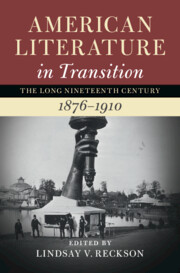Book contents
- American Literature in Transition, 1876–1910
- Nineteenth-Century American Literature in Transition
- American Literature in Transition, 1876–1910
- Copyright page
- Contents
- Contributors
- Series Preface
- Acknowledgments
- Chronology
- Introduction
- Part I Transitive States
- Part II Post-Reconstruction Aesthetics
- Part III Old Materialisms
- Part IV Immanent Techniques
- Chapter 15 Frances Harper’s Reconstruction
- Chapter 16 Emma Lazarus’s Cosmopolitanism
- Chapter 17 Henry James’s Temporalities
- Chapter 18 Charlotte Perkins Gilman’s Pragmatism
- Chapter 19 Nicholas Black Elk’s Cosmology (or, Post-Reconstructing Black Elk)
- Index
Chapter 19 - Nicholas Black Elk’s Cosmology (or, Post-Reconstructing Black Elk)
from Part IV - Immanent Techniques
Published online by Cambridge University Press: 24 August 2022
- American Literature in Transition, 1876–1910
- Nineteenth-Century American Literature in Transition
- American Literature in Transition, 1876–1910
- Copyright page
- Contents
- Contributors
- Series Preface
- Acknowledgments
- Chronology
- Introduction
- Part I Transitive States
- Part II Post-Reconstruction Aesthetics
- Part III Old Materialisms
- Part IV Immanent Techniques
- Chapter 15 Frances Harper’s Reconstruction
- Chapter 16 Emma Lazarus’s Cosmopolitanism
- Chapter 17 Henry James’s Temporalities
- Chapter 18 Charlotte Perkins Gilman’s Pragmatism
- Chapter 19 Nicholas Black Elk’s Cosmology (or, Post-Reconstructing Black Elk)
- Index
Summary
In 1891, a year after the massacre at Wounded Knee, James Mooney proposed to his superior at the Smithsonian’s Bureau of Ethnology to travel west in order to study the Ghost Dance religion, which many white Americans believed was responsible for a spate of recent Lakota-Sioux uprisings in the Great Plains. Part of the first and last generation of professional ethnographers without university training, Mooney was granted his request, and he spent the next two years visiting various tribes in South Dakota, Nebraska, and Nevada, eventually meeting the movement’s originator and prophet, Wovoka (Northern Paiute), in 1892.1 Based on these encounters, Mooney concluded in his seminal The Ghost-Dance Religion and the Sioux Outbreak of 1890 that the religion was, at heart, a peaceful one and that its “great underlying principle … [was] that the time will come when the whole Indian race, living and dead, will be reunited upon a regenerated earth … [t]o live a life of aboriginal happiness, forever free from death, disease, and misery.”2 According to Mooney the dance became violent only among the Lakota Sioux, and then only because of a series of events that set boil to a long-simmering history of broken treaties, brutal treatment, and unhealthy conditions.
- Type
- Chapter
- Information
- American Literature in Transition, 1876–1910 , pp. 367 - 382Publisher: Cambridge University PressPrint publication year: 2022



